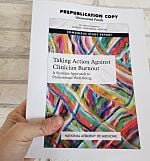 Will recent recommendations of the National Academy of Medicine cause meaningful action to address the burnout epidemic?
Will recent recommendations of the National Academy of Medicine cause meaningful action to address the burnout epidemic?
- Will we look back 10 years from now and say 2020 is when everything changed?
- Do calls for a "positive work environment" mean anything when there are no recommendations on HOW to accomplish that feat?
- What happens in the C-suite when this call to address physician burnout clashes with the organization's drive to maximize profit and shareholder value? (even non-profits must have a margin!)
Get Your Corporate Physician Wellness Strategy
WellMDWorks 3-Step Process is at This Link
=============
In this blog post let's do two things:
2) Give you a copy of the full recommendations so you can do two things:
-
- Print off two copies and carry them with you at all times.
- So when the opportunity arises, you can drop them on your CEO/CMO/CFO's desk and ask that they be adopted in your organization. If your boss can be influenced by consensus statements like this, you want to be ready for their teachable moment.
In future blog posts we will dive into why 2020 may indeed be a turning point for physician wellness, at least in the USA, and the single most effective way burnout can get your C-suite to sit up and take notice.
==========
This is Blog Post #317
Complete Blog Library is Here
==========
DOWNLOAD LINKS:
Get a copy of the full 300 page report here
"Taking Action Against Clinician Burnout: A Systems Approach to Professional Well-Being"
Recommendation 1A.
Health care organizations should develop, pilot, implement, and evaluate organization-wide initiatives to reduce the risk of burnout, foster professional well-being, and enhance patient care by improving the work environment. To accomplish this, they should:
- Commit their executive and board leadership to monitor and continuously improve the clinical work environment.
- Create and maintain, at the health care organization executive level, a leadership role and function responsible for improving and sustaining professional well-being across the organization.
- Assess the foreseeable impact of business and management decisions on the work environment.
- Hold leaders at all levels of the organization accountable for improving the work environment within their scope of responsibility.
Recommendation 1B.
To guide new systems that have been designed to promote professional wellbeing
and patient care quality, health care organizations should adopt and apply the following
principles that improve the work environment and balance job demands and job resources.
- Enhance meaning and purpose in work, and optimize workload and task distribution.
- Establish and sustain an organization-wide and unit-level culture that supports psychological safety and facilitates participatory decision making and peer support.
- Align incentives, compensation, and reward systems for clinicians and work units with organizational and professional values.
- Provide access to resources, such as coaching and adequate time for professional and personal development, to support clinicians in managing stress and adapting to change.
Recommendation 1C.
- Use validated measurement tools to assess the extent of burnout in their organization and the potential contributory factors relevant to their system.
- Obtain clinician and patient input to identify and eliminate documentation and other administrative burdens in the organization that are not mandatory and contribute little or no value to patient care. Assess opportunities to utilize clinical assistants or non-clinical staff to perform the work.
- Conduct reporting, at a minimum annually, overseen by the governing board, on the professional well-being of the organization’s clinicians.
- Use the data to guide system-oriented efforts to prevent and reduce clinician burnout and improve professional well-being as part of a continuous learning and improvement process where data are shared transparently within the organization.
PLEASE LEAVE A COMMENT:

